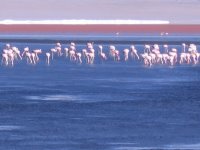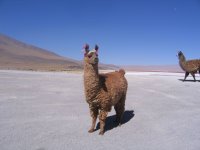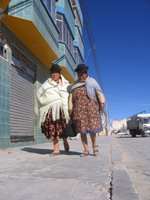CHILE TO BOLIVIA AND BACK TO CHILE


The last couple of weeks have been the most interesting, stimulating, exhausting and enjoyable so far. From the touristic but quaint small adobe village of San Pedro de Atacama, we travelled by 4-wheel drive with a guide named Giyo, his wife (cook) and their month old baby in the front seat, a young Swiss couple and two German girls through the Atacama Desert to Uyumi, where we then caught a bus to La Paz, the highest capital city in the world. The border was a tiny outpost in the desert, and the desert included the largest salt plains in the world as well as some of the highest lakes in the world, and a couple of semi-active volcanoes. This was a bone-jarring 3 day trip, at altitudes of 3600 to 4500 metres, which gave me a 2-day headache to teach me I'm inclined to altitude sickness, and left us all completely ingrained with dust, despite a hotel stay on the second night which allowed us hot showers. The first night was spent at a delapidated outpost with no heating and 4 blankets were not enough to keep out the cold.


The salt plains were so big that you could see the horizon without any interference in all directions, a huge white flat area that was once a large sea, now almost completely salt, and the few odd buildings and even small villages we came across were made from salt rock. These weird places live off the export of the salt, or else men work in copper mines, and many wear overalls and balaclavas to keep out the dust and the sun. We saw sulphur and hot water springs, llamas, vicunas and a kind of ancient rabbit living in outcrops of rock, strange rock formations named after Dali, a petrified tree, and a large rock formation called the Island of Fish.


This we reached on the third morning of the trip, after getting up at 4am to catch the sunrise there. To demonstrate the enormity of the salt lake, Giyo drove for long stretches through the dark with the headlights off, across a huge plain of white nothingness to this island. We got there in time and climbed to the top, breathing very heavily as the altitude got to everyone. The island is covered in 1000-year old cactii and the fossils of shellfish, so it was amazing to consider that it really was an island in the middle of an ocean a few million years ago.


The further north we got in Chile, the more we saw women wearing traditional dress, which consists of layers of colourful skirts, creamy stockings, shirts and shawls, complete with long black platted hair and a small bowler hat which was often perched at jaunty angles on top of the head. The men wear dusty suits and fedora-like wide-brimmed hats, and they have dark brown leathery skin from a lot of time spent outside and a very obviously Indian heritage. They are tough nuggety people only about 1.6m on average in height, and quiet but very friendly. I think it's a tough life for them and doubt if it's a long one. We saw these people more and more as we moved north into Bolivia, and La Paz itself was an interesting mix of people wearing this dress with younger ones wearing jeans and sneakers. But everyone had a mobile.
As soon as we got to Uyumi, the first real town we came across in Bolivia, full of these people, and with a very pleasant open plaza, and decent food and even coffee, we liked Bolivia more than we'd liked Chile. We were even able to indulge in a good pizza as we waited for the bus that took us to La Paz. La Paz is a very large city based at 3600m in the bottom of a valley and climbing up all the steep sides of the valley for hundreds of metres, and it's a wonder the whole thing doesn't come sliding down, which shows it hardly rains there. It's a bustling, buzzing place, with markets everywhere every day, and on our first day there we caught a local minibus to the market in the hills at the top. This is the largest market I've ever seen, stretching up winding stairs and paths, and for miles along open spaces that were like unused building sites, and into streets that went on and on, somehow divided into sections of second-hand clothing, shoes and sneakers, car parts, electrical, plumbing and building materials, you name it, it was there. Also there were pickpockets and armed police, and despite all the warnings and our general alertness to the possibilities, Geoff was robbed. This involved a broken egg thrown at his neck on his left side, an aggressive old woman pushing up against him as he continued to walk, and some very light fingers. He wasn't totally aware of what was happening, but instinct made him keep his left arm down over his shoulder bag instead of lifting it to wipe off the egg, which would have exposed the bag. He wiped it off with his right hand, and as the women kept pushing him, he moved off quickly to the side as soon as he could. Seconds later he was confronted by 3 police, who told us that was an attack and couldn't believe he hadn't lost anything. It wasn't until a little later that Geoff realised his sunglasses had gone from his left jacket pocket, but he was somehow relieved as they were very scratched and now he had the perfect reason to buy a new pair, which he did straight away for $3.
Three days in La Paz were full of colour, good cheap food at markets near our hostel, and a buzz, which Chile didn't have. It's much cheaper because it's poorer, and culturally more stimulating. On the third night, we got on a bus to Copacabana, a small town on Lake Titicaca. This lake is so big it looks like a sea. We walked a lot there, visited a simulation of a floating village made from long grass reeds that people had lived in only 50 years ago, and ate trout in the markets. After 2 days there, we caught a bus back to La Paz and then caught a bus for another overnight trip back across the border into Chile and to the northern beachside town of Iquique, where I'm writing from. This is a really cute town, apparently pretty affluent by comparison with other Chilean towns because of the copper mines, with wide wooden footpaths through the centre of town, old wooden colonial buildings, and a beach with surf. Tomorrow evening we hop on yet another bus for a 24 hour trip back to Santiago, and fly out the next day for Miami, which should be a bit of a culture shock.
0 Comments:
Post a Comment
<< Home